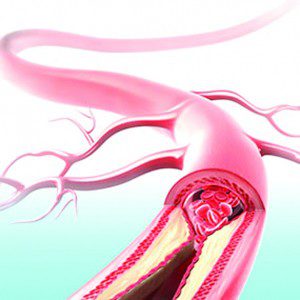 Several types of heart disease are risk factors for stroke. Likewise, stroke is a risk factor for coronary heart disease. Coronary heart disease and stroke share many of the same risk factors such as high LDL “bad” cholesterol levels, low HDL “good” cholesterol levels, high blood pressure, smoking, diabetes, physical inactivity, and being overweight or obese.
Several types of heart disease are risk factors for stroke. Likewise, stroke is a risk factor for coronary heart disease. Coronary heart disease and stroke share many of the same risk factors such as high LDL “bad” cholesterol levels, low HDL “good” cholesterol levels, high blood pressure, smoking, diabetes, physical inactivity, and being overweight or obese.
Individuals with coronary heart disease, angina, or who have had a heart attack due to atherosclerosis, have more than twice the risk of stroke than those who haven’t. If you have atherosclerosis in the coronary arteries you are very likely to have atherosclerosis in other parts of your body.
Hard Arteries
Atherosclerosis is often referred to as “hardening of the arteries.”
Quivering Heart
In atrial fibrillation, the upper chambers of the heart (the atria) quiver instead of beating effectively to move blood into the ventricle.
Problems at the Pump
Heart failure (HF) can also increase stroke risk. HF is a condition in which the heart cannot pump out all the blood that returns to it.
What You Can Do
Although heart disease and stroke account for the vast majority of deaths each year in America, there are things you can do to lessen your risk
Be mindful with your diet.
Healthy food habits can help you reduce three risk factors for heart disease and stroke – high blood cholesterol, high blood pressure and excess body weight. The American Heart Association outlines a healthy diet. It’s based on these dietary recommendations, which are easier to follow than you may think.
Use up at least as many calories as you take in.
Start by knowing how many calories you should be eating and drinking to maintain your weight. Don’t eat more calories than you know you can burn up every day.
Eat a variety of nutritious foods from all the food groups.
You may be eating plenty of food, but your body may not be getting the nutrients it needs to be healthy. Nutrient-rich foods have vitamins, minerals, fiber and other nutrients but are lower in calories. To get the nutrients you need, choose foods like vegetables, fruits, whole-grain products and fat-free or low-fat dairy products most often.
• Vegetables and fruits are high in vitamins, minerals and fiber-and they’re low in calories. Eating a variety of fruits and vegetables may help you control your weight and your blood pressure.
• Unrefined whole-grain foods contain fiber that can help lower your blood cholesterol and help you feel full, which may help you manage your weight.
• Eat fish at least twice a week. Recent research shows that eating oily fish containing omega-3 fatty acids (for example, salmon, trout, and herring) may help lower your risk of death from coronary artery disease.
Eat less of the nutrient-poor foods.
The right number of calories to eat each day is based on your age and physical activity level and whether you’re trying to gain, lose or maintain your weight. You could use your daily allotment of calories on a few high-calorie foods and beverages, but you probably wouldn’t get the nutrients your body needs to be healthy. Limit foods and beverages high in calories but low in nutrients, and limit saturated fats, trans-fats, cholesterol and sodium. Read labels carefully, the Nutrition Facts panel will tell you how much of those nutrients each food or beverage contains. As you make daily food choices, base your eating pattern on these recommendations.
• Choose lean meats and poultry without skin and prepare them without added saturated and trans-fat.
• Select fat-free, 1 percent, and low-fat dairy products.
• Cut back on foods containing partially hydrogenated vegetable oils to reduce trans-fat in your diet.
• Cut back on foods high in dietary cholesterol. Aim to eat less than 300 milligrams of cholesterol each day.
• Cut back on beverages and foods with added sugars.
• Choose and prepare foods with little or no salt. Aim to eat less than 1,500 milligrams of sodium per day.
• If you drink alcohol, do it in moderation. That means one drink per day for women and two drinks per day for men.
• Follow the American Heart Association recommendations when you eat out, and keep an eye on your portion sizes.
Exercise every day.
Balance the number of calories you eat with those you use up each day to maintain your best weight. Walk or do other physical activities for at least 30 minutes on most or all days. To lose weight, burn more calories than you consume daily. But before you start, check with your doctor.
Know your blood pressure.
High blood pressure may not have any symptoms. The only way you will know if your pressure is high is to have it checked. If it is high, you may be able to reduce it with diet and exercise, but if that doesn’t work, medication will likely be necessary. If you take medication, take it exactly as prescribed, not just when you feel like it.
Stop smoking.
There are many benefits to giving up tobacco. If you or a loved one needs an incentive to quit, check out some of the toxic substances in cigarette smoke.
This information is for educational purposes only and is not intended to replace the advice of your doctor or health care provider. We encourage you to discuss with your doctor any questions or concerns you may have.
Dr. Scala has been selected a Castle Connolly 2015 “Top Doctor” by a physician-led team of researchers in the field of Cardiovascular Disease.
Cardiac Care Group
South Cape Business Center
3208 Chiquita Blvd. S, Suite 110
Cape Coral, FL 33914
(239) 574-8463
www.flccg.com









